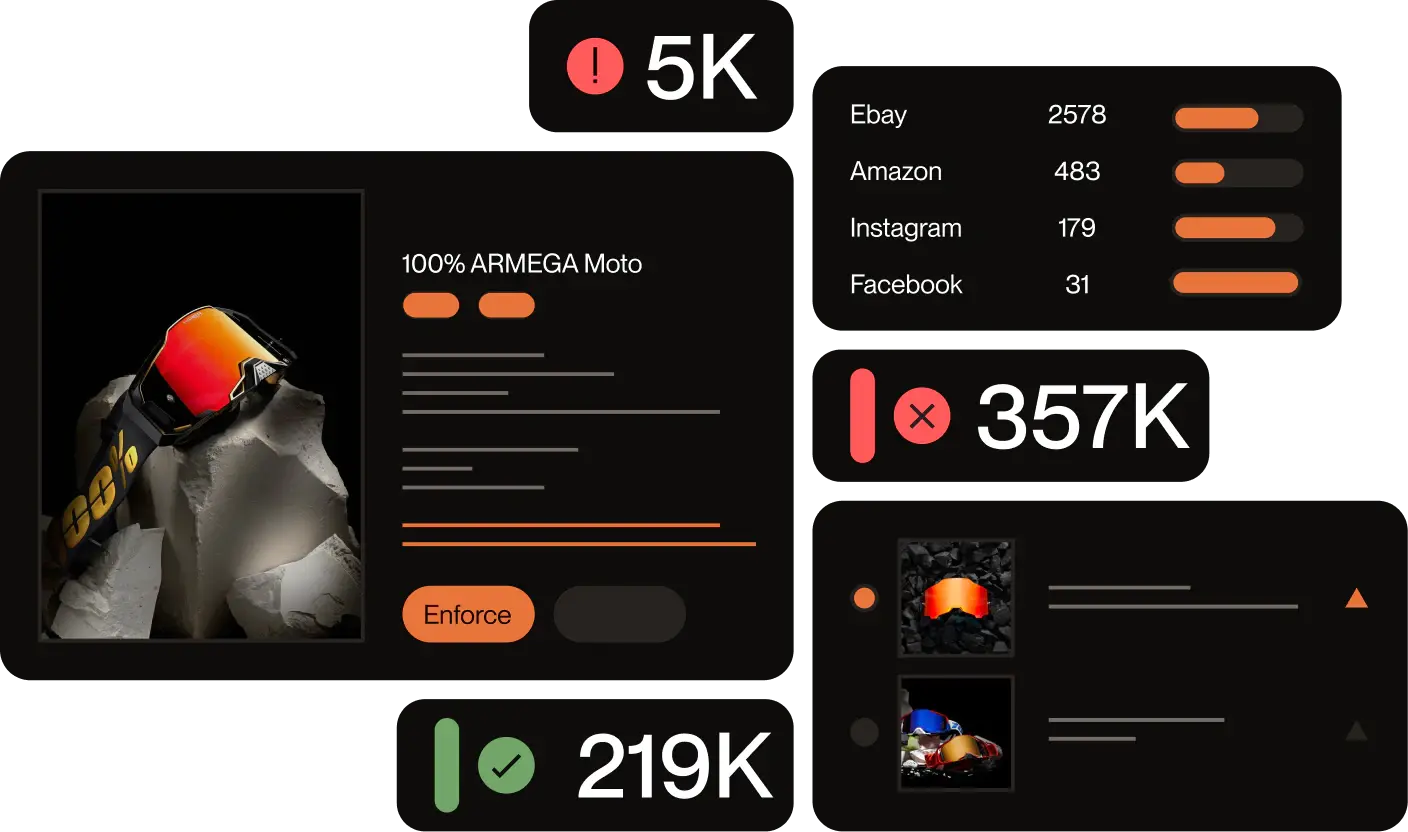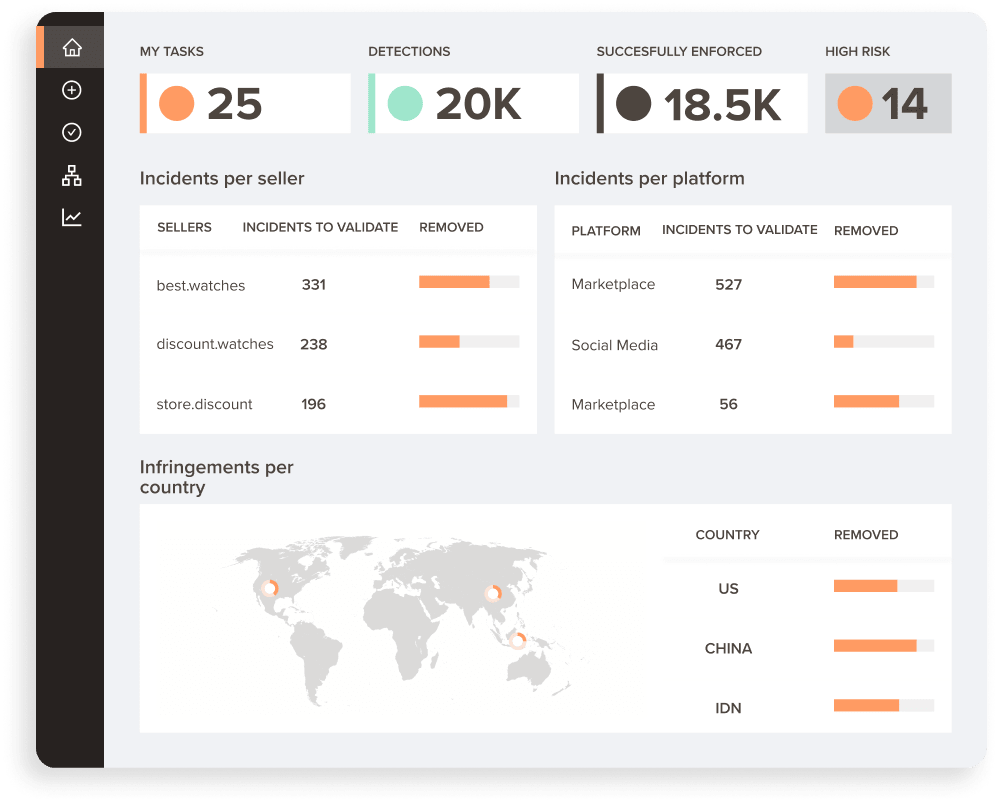One time-tested way for brands to grow is by selling to distributors that can sell to a wide base of customers. But without the ability to track seller behavior and identify unauthorized sellers and resellers, brands are at risk for issues like gray market websites, complaints from other distributors, MAP violation, reputation erosion, and the loss of product exclusivity.
It’s extremely easy for just about anyone to create a seller profile on an ecommerce marketplace and start selling products outside of a brand’s distribution channels. If you use a network of sellers, vendor relationship management is a critical part of your business. Not all of them will follow distribution agreements at all times. The key is to monitor the web to discover unauthorized sellers wherever they emerge. This post will walk you through a step-by-step guide for identifying and stopping unauthorized sellers and resellers.
Summary
- Brands should monitor sites like ecommerce marketplaces, distributor websites, and gray market websites
- Brands can protect themselves by identifying unauthorized sellers, monitoring distributor pricing, and notifying sellers of MAP violations or sending cease and desist notices to unauthorized dealers
What is an unauthorized seller?
An unauthorized seller refers to an individual, business, or entity that sells products without the proper authorization or approval from the brand or manufacturer. These sellers operate outside the official distribution channels established by the brand, often obtaining products through unauthorized means.
Characteristics of unauthorized sellers:
- Lack of Approval: Unauthorized sellers do not have the brand’s permission to sell their products. This can lead to concerns about product authenticity and quality.
- Unregulated Distribution: They often source products through channels not recognized or approved by the brand, potentially compromising the integrity of the supply chain.
- Price Discrepancies: Unauthorized sellers may offer products at significantly lower prices than authorized retailers, which can lead to a distorted market and undercut the brand’s value.
- Brand Image Concerns: The activities of unauthorized sellers can impact a brand’s reputation and image, especially if customers receive counterfeit or subpar products.
- Customer Experience: Purchasing from unauthorized sellers can result in inconsistent customer experiences, as they might not provide the same level of service or support as authorized retailers.
- Marketplace Challenges: Unauthorized sellers are often found on online marketplaces, making it harder for consumers to distinguish between legitimate and unauthorized offerings.
Dealing with unauthorized sellers:
Brands often employ various strategies to combat unauthorized sellers, including monitoring online marketplaces, sending cease-and-desist letters, and implementing distribution agreements. The goal is to protect the brand’s reputation, maintain control over pricing, and ensure that customers receive genuine products and a consistent brand experience.
How do unauthorized sellers impact your brand?
Unauthorized sellers can have far-reaching negative effects on your brand’s reputation, sales, and overall business success. Here’s how their activities can harm your brand:
1.Product Quality Concerns:
Unauthorized sellers might source products through questionable channels, leading to the distribution of counterfeit or substandard items. This can erode customer trust in your brand’s quality and authenticity.
2. Pricing and Value Perception:
Unauthorized sellers often undercut official pricing, creating an inconsistent pricing landscape. This can lead to confusion among consumers and devalue your brand in the eyes of customers seeking premium products.
3. Customer Experience Disruption:
Purchasing from unauthorized sellers can result in inconsistent customer experiences. Customers might not receive proper after-sales support, warranties, or guarantees, tarnishing their perception of your brand.
4. Loss of Brand Control:
When unauthorized sellers flood the market, it becomes challenging to maintain control over your brand’s image, messaging, and distribution. Your brand’s reputation could suffer from the misrepresentation of products.
5. Channel Confusion:
With unauthorized sellers operating alongside authorized retailers, customers may struggle to distinguish legitimate products from unauthorized ones. This confusion can lead to a loss of trust and loyalty.
6. Strained Relationships:
Authorized distributors and retailers may feel alienated when unauthorized sellers undermine their efforts. This strain can disrupt your established network and partnerships.
7. Legal and Intellectual Property Issues:
Unauthorized sellers may infringe upon your intellectual property rights, leading to legal battles and additional costs.
8. Marketplace Saturation:
The presence of unauthorized sellers in online marketplaces can saturate the market with your products, making it harder for authorized sellers to stand out.
Which sites should you monitor?
Let’s take a look at three main areas you should monitor to protect your pricing power and stop unauthorized sellers.
Marketplaces
Marketplaces like Amazon and Walmart.com allow brands to grow and reach more customers through third-party sellers, but they also present some challenges. You may have a variety of legitimate third-party sellers across several marketplaces, but some may violate your MAP policy from time to time. MAP violations can erode your pricing power online and even affect your in-store pricing. Customers can check Amazon to find the price of an item before visiting your store, and if it’s much cheaper online, they’ll avoid purchasing from your store.
Also, when you search for your products online, you might notice some sellers that are unfamiliar to you and not part of your distribution network. The barriers to entry are low for selling on platforms like Amazon. Unauthorized sellers and resellers only need to get their hands on gray market products and set a competitive price.
Seller’s website
Vendor management should also include monitoring seller websites to ensure compliance. It’s possible for distribution partners to go against your MAP policy to sell items faster or get an edge in their market. However, that can lead to other sellers complaining to your organization about losing sales or pricing power. Plus, when customers can find your items at a variety of different prices, they may question the real value of the item. Or, they may wonder why they paid a certain amount for a product when different businesses offer it for cheaper.
Individual grey market websites
Particular products lend themselves to entire ecosystems of gray market sites. Watches, cameras, cars, and perfumes are all examples of products targeted by gray market sites. Different factors can influence how certain products end up on the gray market.
For example, an economic recession can decrease consumer discretionary spending, and watch distributors may end up with piles of old stock in their warehouses. Distributors will then feed the gray market by offloading stock to resellers outside official distribution channels. A watch collector may enjoy lower prices from a gray market site, but they won’t get any after-sale support or warranty coverage from the manufacturer.
Consumers risk their safety when purchasing other products on the gray market, like pharmaceuticals, cosmetics, and vehicles. If you see your products on a gray market site, that’s a good sign that you need to be more aware of distributor and vendor management.
How to protect your brand from unauthorized sellers in 3 steps
There are three main steps to protecting your brand from unauthorized resellers: identify rogue sellers, monitor pricing, and send cease and desist letters to unauthorized dealers.
Step 1: Identify rogue sellers
You can’t take any action until you know who to go after. Today, an advanced monitoring system can scan marketplaces, seller websites, and gray market websites to look for instances of your brand and products.
A monitoring system can also work to connect the dots between multiple seller accounts and find contact information and make enforcement more effective. With information on unauthorized resellers, you can also uncover how they purchased your products to see which of your distributor contracts needs attention.
Step 2: Monitor pricing
In addition to identifying unauthorized resellers, you can use monitoring tools to make sure the dealers in your supply chain are following your MAP policy. This makes distribution contract management easier. With continuous monitoring, you’ll know when a seller goes against your policy. You can act quickly and maintain your pricing power in the market.
Step 3: Notify/send cease and desist to unauthorized dealers
You now have two types of alerts to take action with unauthorized sellers and resellers and authorized sellers that are selling below MAP. The last step is to notify these parties in the right way. You don’t want to send a cease and desist letter to a legitimate seller and possibly harm the relationship, after all. With a legitimate company, you can let them know you’re aware they are selling under MAP and outline the steps you’ll take to enforce that if they don’t comply.
On the other hand, let’s say you found unauthorized sellers who did not sign a MAP policy agreement with you. This is where cease and desist notices come in. Also, if they are selling your products as “New,” you can make a case to Amazon (or another platform) that new products require your warranty, but since the seller is unauthorized, they can’t offer the warranty. This can give you another way to stop unauthorized sellers, remove the listing and solve the issue.
What’s next
The purpose of a vendor tracking and monitoring solution is to make it easier to have healthy relationships with your distributors and to notify and remove unauthorized listings quickly. No one has time to manually sift through new listings on dozens of platforms, which is why an automated solution is necessary. With the Red Points online distributor compliance platform, you can take advantage of machine learning and AI to uncover all sellers of your products online, whether legitimate or not.








